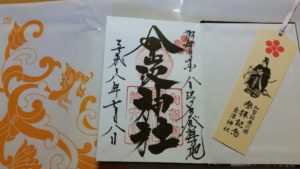During the past week, I found that I was able to use my language acquisition thus far in an important way: really beginning to investigate the cultural nuances of Japan. That is not to say that I suddenly shot up in fluency during the past week, nor that I have only just begun to really question and investigate the unique elements of Japanese life. However, I certainly felt an intersection of language learning and cultural exchange, an intersection that I was incredibly happy to have encountered.
As part of the summer language program I am participating in, students choose a topic unique to Japan to research and compose a speech for. I chose Shintoism. For those not in the know, Shintoism is what might be called a natively Japanese religion, though depending on who you ask, “religion” may not fully encapsulate what Shinto means for Japan. But at a fundamental level, Shinto focuses on the various gods of Japanese tradition, called 神 (かみ) (kami), which are numerous and may be found everywhere, inhabiting anything. The Shinto place of worship is called a 神社 (じんじゃ) (jinja), which are typically a collection of structures with an open, central space, accompanied by plenty of nature. Jinja are generally dedicated to a single kami.

Many festivals in Japan call for visitation of jinja, or of Buddhist o-tera (a temple). In addition, many rituals are often conducted at jinja, such as the blessing of newborn infants for healthy life. Various kinds of symbolry can be bought at jinja, such as omamori (charms for health, or for studying, or for marriage, and so on), and goshuinchoo (a book in which jinja priests can write the sign of their jinja, sort of like a pilgrim’s passport, to be taken to and signed at various shrines until the book is filled).

The place of Shinto in modern Japan is a question that I wanted to search out, and thanks to my hostmother, after a few connections were followed, I was given the opportunity to meet with the priest of a jinja in Kanazawa. The priest is a very interesting and engaging man with a passion for people. And after meeting him, and not only learning about Shinto but about his own life, I think I have come to understand Shinto a little bit more (though I have he feeling that, as with most beliefs, there is ever more to contemplate). What I mean by this vaguery is that for the priest I met with, Shinto is much more about how one lives than what one “believes,” per se. The very unique element of Shintoism is that other religions do not contradict Shintoism’s core beliefs. For example, Buddhism exists alongside, and in certain areas (such as death rituals) symbiotically collaborates wth, Shintoism. Many houses contain shrines dedicated to both Shinto kami and Buddhist hotoke (in Japan, Buddhas who are treated as gods, as I understand). But, Shinto can also just as easily accept Christ into its worldview.
As the priest noted, Shinto is very much about the lifestyle of an older Japan: showing appreciation for things as small as a grain of rice; the preciousness of nature and its power to affect human lives; the importance of recalling those who came before; and, of course, acknowledging how very human we all are in the scope of the world and beyond.

The entire conversation really helped open my eyes to something running beneath Shinto, which is to say the currents of Japanese tradition that, though not obvious or even tangible, are present. The priest told me, even if a Japanese person does not practice Shintoism, they likely live out Shinto principles–because the kernel of Shinto is the kernel of Japan.
However, during our discussion I had to raise an important question: what about the young people? Youth, of course, being the free radical of any society. Do younger generations hold to Shintoism as do their elders? The reply was a predictable “not enitrely.” While there are always going to be people with an interest in faith, the priest definitely feels there is a declining interest. Part of this decline, he said, is that many newer generations are no longer receiving the traditional upbringings that youth once did; Shinto, sharing greatly in the traditions of Japan, necessarily suffers as a result. Shinto may align with the lifestyle and way of thought for Japan, but what happens when lifestyles and thought begin to shift?
This question of generational change is obviously of great interest in a country like Japan, one with years of very particular tradition but with very rapid modernization over the past two hundred years. Such change is especially interesting in language study. Vernacular is a great way to trace the shifts between generations, such as in slang usage. For example, when I brought up slang with my hostmom, she said that Japanese チョ (cho) is a common way to emphasize something; an English equivalent might be “totally,” or “way,” as in “totally cool” or “way tight” (I’m sorry for my suburban lingo). But, she said, one would never use cho with a superior, and in a country like Japan where entire grammar structures are dedicated to superior-inferior relationships, this is an important warning.
However, when talking with local university students, they had a different opinion. As one girl told me, やばい (yabai) is currently a trending word among younger Japanese. While yabai literally translates as “dangerous,” current usage follows such interpretations as “great” or “cool.” It is a versatile slang word. Importantly, when talking with a group of older Japanese parents at a neighborhood party, they collectively understood yabai stricty in its literal interpretation; the slang usages were new to them. And thus, but one sign of the generational gap, in no more than three syllables.
Right, thank you for reading.
Joshua Kuiper
カイパーヨシュア
